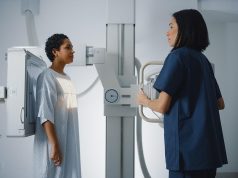The 2017 Gastrointestinal Cancers Symposium
The American Society of Clinical Oncology’s 13th annual Gastrointestinal Cancers Symposium was held from Jan. 19 to 21 in San Francisco and attracted approximately 3,000 participants from around the world, including gastrointestinal oncology specialists and other health care professionals. The conference featured presentations focusing on the latest advances in the diagnosis and management of gastrointestinal cancers.
In one study, Scott Kopetz, M.D., Ph.D., of the MD Anderson Cancer Center in Houston, and colleagues found that vemurafenib combined with cetuximab and irinotecan improved outcomes in patients with metastatic colorectal cancer (mCRC) versus irinotecan and cetuximab only.
“BRAF mutation is present in 7 percent of mCRC, which is associated with poor outcomes. However, single agent inhibition with BRAF or EGFR inhibition doesn’t work in this population,” Kopetz said. “Instead, preclinical and early clinical data suggest that the combination of the two is needed to provide benefit, leading to this randomized study of irinotecan, EGFR inhibition with cetuximab, with or without BRAF inhibition.”
The investigators enrolled 106 patients with the primary end point of progression-free survival.
“This was a positive study with hazard ratio of 0.42, P value of 0.0002. Disease control rates were also higher in the vemurafenib arm. Added toxicities included neutropenia, anemia, and nausea,” Kopetz said. “This is the first randomized study to demonstrate activity of BRAF inhibition in BRAF-mutated CRC. This will provide a new option for our patients.”
Several authors disclosed financial ties to pharmaceutical and medical device companies, including Genentech, the manufacturer of vemurafenib.
Abstract No. 520
In another study, Karyn A. Goodman, M.D., of the University of Colorado School of Medicine in Aurora, and colleagues evaluated the use of positron emission tomography (PET) to determine if a chemotherapy regimen was effective based on response as measured on a PET scan after only a few cycles of chemotherapy. If the chemotherapy was ineffective, it was changed to an alternative regimen during the standard course of chemoradiation.
“In patients who were deemed to be PET non-responders in prior studies and their chemotherapy was not changed, the pathologic complete response rates were generally around 5 percent. In our study, for the patients who were PET non-responders who crossed over to alternative chemotherapy during chemoradiation, the pathologic complete response rate was 18 percent (19 percent for FOLFOX to Carbo/Taxol and 17 percent for Carbo/Taxol to FOLFOX), which met the pre-specified efficacy criteria, so this was a positive study,” Goodman said. “This was the first study in solid tumors showing benefit of a new paradigm of using metabolic imaging to individualize multimodality therapy and improve outcomes in this poor-prognosis population. However, we don’t know yet if the pathologic complete response improvements will translate into a survival benefit. We are awaiting the progression-free survival outcomes with longer follow up.”
Several authors disclosed financial ties to the pharmaceutical and medical device industries.
Abstract No. 1
Maxime Van der Valk, M.D., of the Leiden University Medical Center in the Netherlands, and colleagues aimed to provide more knowledge on the risks and benefits of watch-and-wait strategies in rectal cancer by collecting all available data on watch-and-wait strategies worldwide through the International Watch & Wait database, an international collaborative platform.
“There are still major differences in watch-and-wait strategies in rectal cancer patients worldwide, in particular when patients are considered eligible for watch-and-wait, which type and dosage of chemotherapy is given and which imaging modalities are used,” Van der Valk said. “In 25 percent of all patients, tumor regrowth occurred; the majority of this regrowth was seen in the first two years. We also looked at the survival of these patients, and the three-year overall survival rate was 92 percent.”
Van der Valk also noted that currently available data on watch-and-wait strategies in rectal cancer are heterogeneous. Most tumor regrowth occurred in the first two years, so in this period the follow-up regimen should be most intense.
“To our knowledge, this is the largest series on watch-and-wait treatment in rectal cancer patients. The watch-and-wait strategy has gained interest over the last decades, and this study (but also other previously reported studies) illustrates the importance of a restaging (reassessment) after treatment with chemoradiotherapy to assess the tumor response,” Van der Valk said. “Also, it illustrates the need for a homogeneous international watch-and-wait protocol; this is one of the things that our consortium will focus on in the future.”
Abstract No. 521
ASCO: Moderate Activity Tied to Longer Survival in Advanced CRC
WEDNESDAY, Jan. 18, 2017 (HealthDay News) — Just a half hour a day of moderate physical activity could improve survival odds for patients with metastatic colorectal cancer (CRC), according to a study presented at the American Society of Clinical Oncology’s annual Gastrointestinal Cancers Symposium, held from Jan. 19 to 21 in San Francisco.
Copyright © 2017 HealthDay. All rights reserved.







